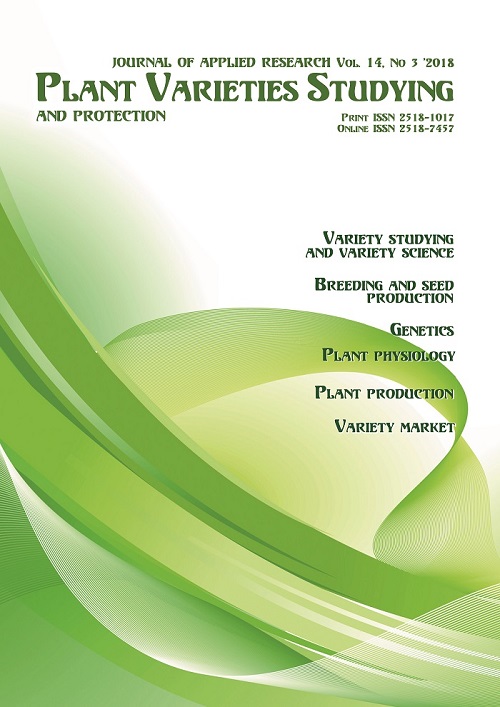Analysis of the phytosanitary state of crops of various soybean varieties in the conditions of the Southern Steppe of Ukraine
DOI:
https://doi.org/10.21498/2518-1017.14.3.2018.145300Keywords:
soybean, phytosanitary condition of crops, fungal, bacterial and viral diseases, composition of pathogen species, immunological assessment of varietiesAbstract
Purpose. To analyze the phytosanitary state of soybean crops in the conditions of the Southern Steppe of Ukraine and to determine the most resistant cultivars to the complex of diseases for further use in breeding practice.
Methods. 35 soybean sorts of different origin from the collection of the Plant Breeding and Genetics Institute – National Center of Seed and Cultivar Study (NAAS) were under research. Resistance of soybean varieties to peronosporosis, phomopsis and ash rot was evaluated in the context of natural infectious process and to a fusariosis – on a provocative basis.
Results. The species composition of soybean pathogenic diseases was determined during the planting in the conditions of the Southern Steppe of Ukraine. During the vegetation period the development of sprout fusariosis and root rot, on adult plants in the flowering phase – perenospores, in the phase of beans ripening – ash rot, stems and beans burn and other diseases were observed. The most common in soybean agrocenosis were representatives of mycoflora: Fusarium sp., Pevonospora manskurica (Naum.) Syd., Macrophomina phaseolina (Tassi.) Goid., Diaporthe phaseolorum (Cke. Et Ell) Sacc. var. sojae Wehm. It is worth to note that the specific composition of pathogens varied in dependence of soy cultivar. The varieties ‘Lambert’, ‘Yurivka’ and ‘Yuvileina’ were dominated with the infection of Fusarium spp., and also a large number of plants was infected by P. manskurica perenosporosis. ‘Chernovytska 8’ variety stood out with intense ash rot infestation. In the pathogenic complex ‘Apolon’, ‘Odesa 150’, ‘Yurivka’ and ‘L-2’ varieties the emergence of ash rot and phomapsis were marked. ‘Apolon’, ‘Ustia’ and ‘L-2’ varieties were diagnosed with phomopsis.
Conclusions. According to the analysis, the soybean varieties ‘Arkadiia Odeska’, ‘Chornobura’, ‘Yatran’, ‘Berehynia’, ‘Stepovychka’, ‘Znakhidka’, ‘Medeia’, ‘Mariana’, ‘Vasylkivska’, ‘Faeton’, ‘Selekta’ were characterized by the complex resistance to fusariosis, peronosporosis, ash rot and phomopsis.
Downloads
References
Pospielova, H. D. (2015). Phytopathogenic species of soybean seeds. Vìsn. Poltav. derž. agrar. akad. [News of Poltava State Agrarian Academy], 1–2, 44–48. [in Ukrainian]
Lykhchvor, V. V., Bomba, M. I., & Dubkovetskyi, S. V. (1999). Dovidnyk z vyroshchuvannia zernovykh i zernobobovykh kultur [Handbook for growing cereals and legumes]. Lviv: Ukrainski tekhnolohii. [in Ukrainian]
Lisovyi, M. P. (Ed.). (1999). Dovidnyk iz zakhystu roslyn [Guide for plant protection]. Kyiv: Urozhai. [in Ukrainian]
Khokhryakov, M. K. (2003). Opredelitel’ bolezney rasteniy [The plant diseases identifier]. (3rd ed.). Saint-Petersburg; Moscow: Lan’. [in Russian]
Peresypkin, V. F. (2000). Silskohospodarska fitopatolohiia [Agricultural phytopathology]. Kyiv: Ahrarna osvita. [in Ukrainian]
Omeliuta, V. P. (Ed.). (1986). Oblik shkidnykiv i khvorob silskohospodarskykh kultur [Pests and diseases of agricultural crops]. Kyiv: Urozhai. [in Ukrainian]
Petrenkova, V. P., Cherniaieva, I. M., & Markova, T. Yu. (2004). Nasinnieva infektsiia polovykh kultur [Seed infections of field crops]. Kharkiv: Mahda LTD. [in Ukrainian]
Tkachyk, S. O. (Ed.). Metodyka provedennia fitopatolohichnykh doslidzhen za shtuchnoho zarazhennia roslyn [Methods for phytopathological study with plant experimental infestation] (p. 7). Vinnytsia: FOP Korzun D. Yu. [in Ukrainian]
Leshchuk, N. V., Mazhuha, K. M., Orlenko, N. S., Starychenko, Ye. M., & Shkapenko, Ye. A. (2017). Comparative analysis of statistical software products for VCU qualifying examination of plant varieties. Plant Varieties Studying and Protection, 13(4), 429–435. doi: 10.21498/2518-1017.13.4.2017.117757
Downloads
Published
How to Cite
Issue
Section
License
Copyright (c) 2018 Ukrainian Institute for Plant Variety Examination

This work is licensed under a Creative Commons Attribution-ShareAlike 4.0 International License.
Starting in 2022, the copyright to the publication remains with the authors
Our journal abides by the CREATIVE COMMONS copyright rights and permissions for open access journals.
Authors, who are published in this journal, agree to the following conditions:
- The authors reserve the right to authorship of the work and pass the first publication right of this work to the journal under the terms of a Creative Commons Attribution License, which allows others to freely distribute the published research with the obligatory reference to the authors of the original work and the first publication of the work in this journal.
- The authors have the right to conclude separate supplement agreements that relate to non-exclusive work distribution in the form in which it has been published by the journal (for example, to upload the work to the online storage of the journal or publish it as part of a monograph), provided that the reference to the first publication of the work in this journal is included.

























 Ukrainian Institute for Plant Varieties Examination
Ukrainian Institute for Plant Varieties Examination  Селекційно-генетичний інститут
Селекційно-генетичний інститут Institute of Plant Physiology and Genetics of the National Academy of Sciences of Ukraine
Institute of Plant Physiology and Genetics of the National Academy of Sciences of Ukraine
 The National Academy of Agrarian Sciences of Ukraine
The National Academy of Agrarian Sciences of Ukraine